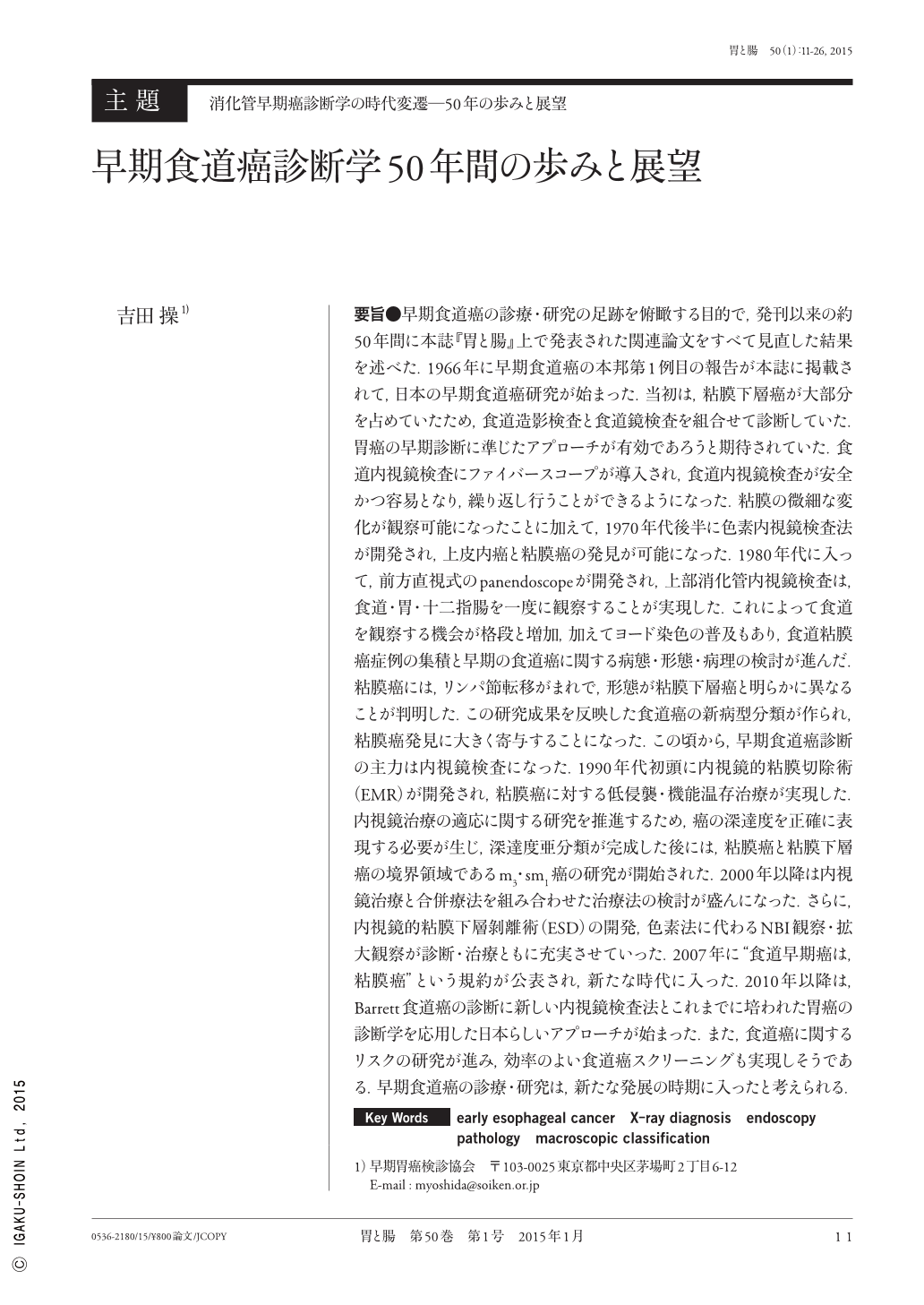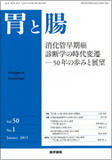Japanese
English
- 有料閲覧
- Abstract 文献概要
- 1ページ目 Look Inside
- 参考文献 Reference
要旨●早期食道癌の診療・研究の足跡を俯瞰する目的で,発刊以来の約50年間に本誌『胃と腸』上で発表された関連論文をすべて見直した結果を述べた.1966年に早期食道癌の本邦第1例目の報告が本誌に掲載されて,日本の早期食道癌研究が始まった.当初は,粘膜下層癌が大部分を占めていたため,食道造影検査と食道鏡検査を組合せて診断していた.胃癌の早期診断に準じたアプローチが有効であろうと期待されていた.食道内視鏡検査にファイバースコープが導入され,食道内視鏡検査が安全かつ容易となり,繰り返し行うことができるようになった.粘膜の微細な変化が観察可能になったことに加えて,1970年代後半に色素内視鏡検査法が開発され,上皮内癌と粘膜癌の発見が可能になった.1980年代に入って,前方直視式のpanendoscopeが開発され,上部消化管内視鏡検査は,食道・胃・十二指腸を一度に観察することが実現した.これによって食道を観察する機会が格段と増加,加えてヨード染色の普及もあり,食道粘膜癌症例の集積と早期の食道癌に関する病態・形態・病理の検討が進んだ.粘膜癌には,リンパ節転移がまれで,形態が粘膜下層癌と明らかに異なることが判明した.この研究成果を反映した食道癌の新病型分類が作られ,粘膜癌発見に大きく寄与することになった.この頃から,早期食道癌診断の主力は内視鏡検査になった.1990年代初頭に内視鏡的粘膜切除術(EMR)が開発され,粘膜癌に対する低侵襲・機能温存治療が実現した.内視鏡治療の適応に関する研究を推進するため,癌の深達度を正確に表現する必要が生じ,深達度亜分類が完成した後には,粘膜癌と粘膜下層癌の境界領域であるm3・sm1癌の研究が開始された.2000年以降は内視鏡治療と合併療法を組み合わせた治療法の検討が盛んになった.さらに,内視鏡的粘膜下層剝離術(ESD)の開発,色素法に代わるNBI観察・拡大観察が診断・治療ともに充実させていった.2007年に“食道早期癌は,粘膜癌”という規約が公表され,新たな時代に入った.2010年以降は,Barrett食道癌の診断に新しい内視鏡検査法とこれまでに培われた胃癌の診断学を応用した日本らしいアプローチが始まった.また,食道癌に関するリスクの研究が進み,効率のよい食道癌スクリーニングも実現しそうである.早期食道癌の診療・研究は,新たな発展の時期に入ったと考えられる.
In order to follow the development of studies on early esophageal cancer in Japan, every paper in “Stomach and Intestine” dealing with endoscopy, X-ray study, pathology and others in this field from 1966 to 2013 were reviewed. Studies on early esophageal cancer had started following the first case report of early esophageal cancer in Japan in “Stomach and Intestine” 1966. Most of early esophageal cancer was submucosal cancer in 1960's and 1970's. X-ray study and endoscopy cooperated in detection and evaluation of “early esophageal cancer”. Development of the fiberscope allowed us to identify very slight mucosal changes of the esophagus such as coarseness, redness, discoloring, slight elevation and slight depression. Chromoendoscopy such as iodine staining or staining made it easy and accurate to detect squamous cell carcinoma confined to the esophageal mucosa in the second half of 1970's. The pan-endoscope for upper GI endoscopy was established in the early 1980's and it gave us frequent occasions of endoscopic observation of esophageal mucosa. Numbers of mucosal cancer cases had been accumulated as the iodine staining prevailed in Japan. Large number of studies on endoscopy, X-ray study, pathology and biological behavior of mucosal cancer of the esophagus revealed difference between mucosal cancer and submucosal cancer. Lymph node metastasis is rare among mucosal cancers but it was frequent among submucosal cancers. Those facts resulted excellent prognosis of mucosal cancer after esophagectomy and poor in case of submucosal cancer. Macroscopic findings of mucosal cancers were different from that of submucosal cancers. The new macroscopic classification of esophageal cancer reflecting those studies allowed us to identify mucosal cancers as type 0-II (IIa, IIb and IIc) lesions other than type 0-I or type 0-III cancers that strongly suggestive of cancer invasion into the submucosa. Three endoscopic mucosal resection techniques such as the 2-channel method (Momma), the tube method (Makuuchi) and the cap method (Inoue) had established in early 1990's. Endoscopy became the mainstay in diagnosis and treatment of mucosal cancer of the esophagus. Further studies on mucosal cancer of the esophagus asked us to make the subclassification of the depth of cancer invasion such as m1 (intraepithelial cancer), m2 (cancer invasion into the lamina propria mucosae) and m3 (cancer invasion into the muscularis mucosa). The cancer invasion into the submucosa was divided into three categories such as sm1 (invasion into the superficial 1/3 of the submucosa), sm2 (invasion into the middle third of the submucosa) and sm3 (invasion into the deeper 1/3). Macroscopic, microscopic findings and biological behavior of the m3 and sm1 cancers were studied to establish the function preserving treatment for them. Clinico-pathological studies on resected specimens by EMR revealed a lymphatic permeation, diffuse cancer infiltration or poor differentiation closely related to frequent lymph node metastasis. Additional treatments including radical esophagectomy, chemotherapy and chemoradiation were recommended for patients at risk. Early in the 2000's, the Japan Esophageal Society revised the Japanese classification of esophageal cancer. They decided the definition of early esophageal cancer as “cancers with invasion confined to the mucosa”. Some new challenges on early esophageal cancer have started such as the NBI (narrow band imaging), magnify observation made endoscopic cancer detection easier and estimation of depth of invasion accurate. ESD (endoscopic submucosal dissection) allowed us to remove large mucosal cancer in one resected specimen. Nowadays, we are challenging to establish an advanced endoscopic diagnosis and treatment of Barrett's cancer applying new endoscopic measures and clinic-pathological studies on gastric cancer in Japan. Some genetic abnormalities are strongly suggestive of patients with high risk for esophageal cancer and it probably allow us to built up a new endoscopic surveillance system for esophageal cancer. We may expect additional developments in the field of early esophageal cancer in Japan.

Copyright © 2015, Igaku-Shoin Ltd. All rights reserved.


